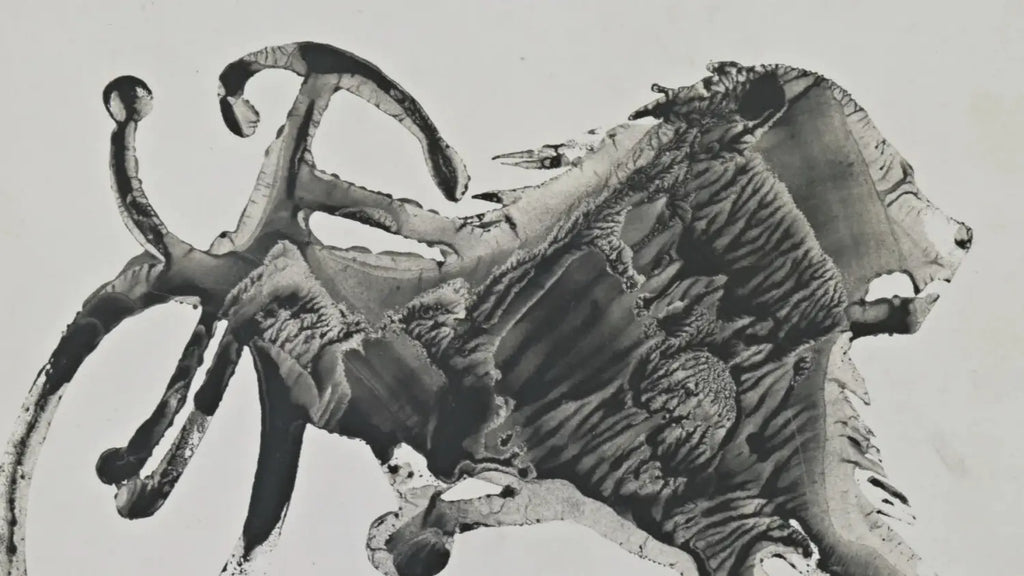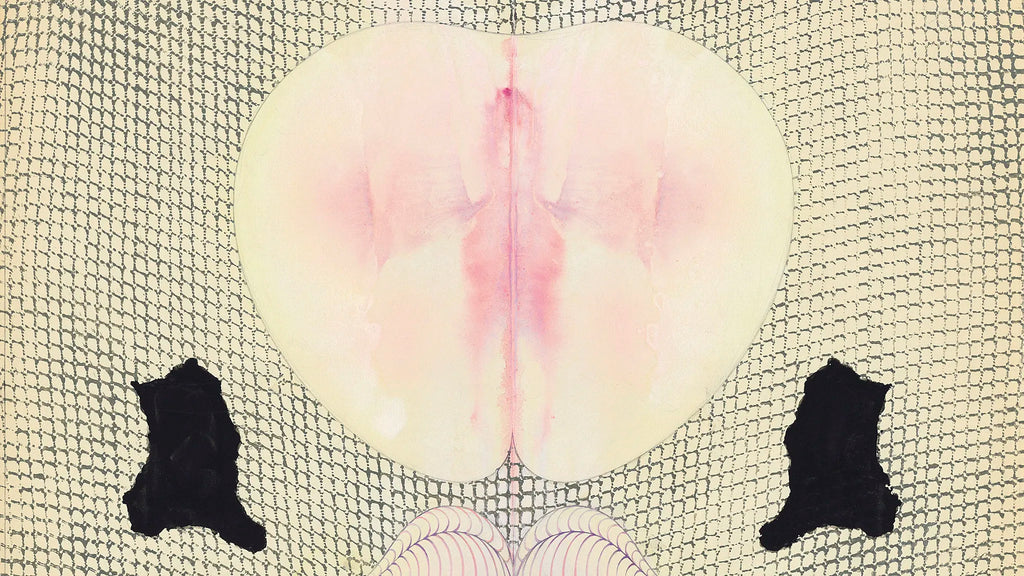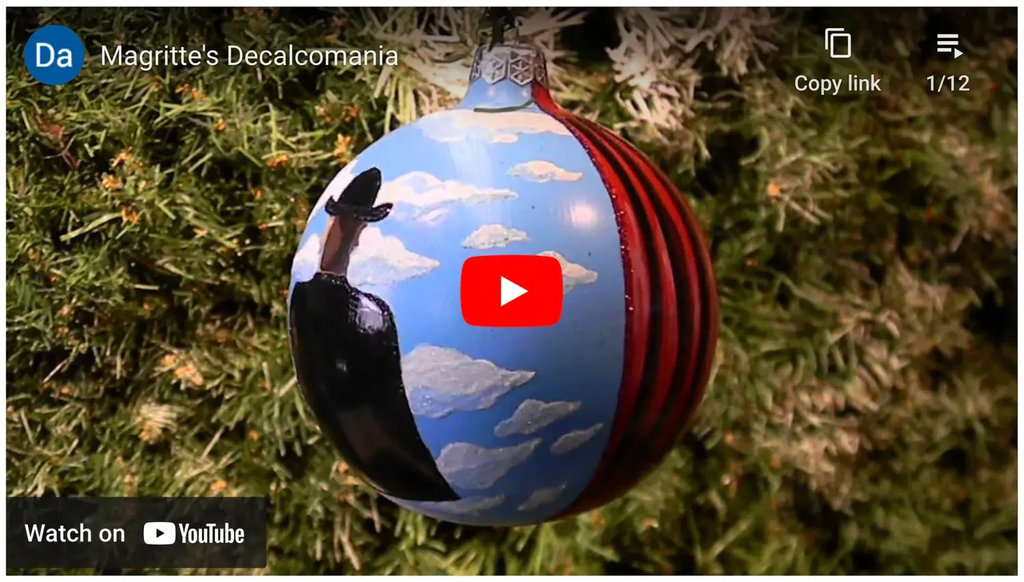摘要,超凡脱俗和有机:达甲嘉律艺术的混乱魔力
DeCalcomania是一种超现实主义技术,涉及通过在两个表面之间按湿油漆或墨水来创建抽象图案,然后将它们分开以揭示独特的有机设计。该方法由德国艺术家Max Ernst普及,他在20世纪初通过Oscar Dominguez开创了该技术。
在本文中,我们将探讨Decalcomania的历史,超现实主义艺术家如何使用它,分步说明创建您自己的Decalcomania艺术,以及展示一些最著名的Decalcomania艺术作品。
十曲的历史
Decalcomania是一种装饰技术,可以将其版画和印刷品转移到陶器或其他材料中。该技术最初是在1750年左右在英格兰商业使用的,并进口到美国 至少早在1865年。它的发明归因于法国的雕刻师西蒙·弗朗索瓦·拉维内特(SimonFrançoisRavenet)décalquer".
该过程涉及将墨水,油漆或其他培养基涂在表面上,并且在仍然湿润的同时,用纸,玻璃或铝箔等材料覆盖。删除时, 材料转移模式 这可能会进一步点缀。达甲虫下最常见的例子涉及 将油漆涂在纸上然后折叠,施加压力,然后展开纸张以揭示镜面图案。
除了在美术中使用外,达卡马尼亚州还用于商业应用中,例如批量生产的商品艺术转移或产品标签,称为“贴花”。玻璃化曲伐尼亚是一种用于将装饰或铭文转移到陶瓷,玻璃,钣金,铸造金属或任何其他材料的类型类型的类型 给人留下深刻的印象.
超现实主义艺术中的十二comania
超现实主义者采用了该技术来偶然地创建图像,而不是通过有意识的控制。超现实主义者ÓscarDomínguez将他的作品称为“没有先入为主的对象”的“达甲嘉律”。他在1936年采用了该技术,使用水粉稀薄地在一张纸或其他表面上散布(玻璃已经使用),然后将其按在另一个表面(例如画布)上。 Domínguez使用了黑色水粉,尽管颜色后来出现了。德国艺术家麦克斯·恩斯特(Max Ernst)也练习了达卡马尼亚(Decalcomania),汉斯·贝尔默(Hans Bellmer)和雷梅迪奥斯·瓦罗(Remedios Varo)也是如此。萨尔瓦多·达利(Salvador Dali)也涉足 - 见下文。
该技术使艺术家能够创造出抽象,超凡脱俗的景观,以及挑战传统代表和现实概念的生物。所得图像通常类似于景观,有机形式或抽象形状,并且技术 严重依赖机会和自发性.
达伐典礼中发现的超凡脱俗或梦幻般的模式适合超现实主义者的目的。像恩斯特(Ernst)这样的艺术家将利用揭示洞穴,树木,岩层的转移效果。
的颜色,形状和标记 抽象主义 提供一种创新的视觉语言,使艺术家能够传达情感,思想和经验。
少关注艺术品的主题,创建抽象艺术的过程和材料具有更大的重要性。质地,深度,尤其是颜色成为传达艺术家意图的重要工具。
创建自己的脱卡马尼亚艺术
创建自己的Decalcomania艺术是一个有趣而简单的过程,需要最少的材料。这是分步指南...
- 首先准备工作表面。 用一层塑料或蜡纸盖住它,以保护它免受湿油漆的侵害。
- 选择您的油漆。 丙烯酸涂料适用于此技术,但是您可以尝试其他类型的油漆。
- 将一层油漆涂在一个表面上。 您可以使用画笔或调色刀涂油漆。确保层足够厚,可以产生图案,但不会太厚,以至于干燥需要很长时间。
- 将另一个表面压入彩绘表面。 您可以使用纸,画布,甚至可以使用其他物体,例如叶子或一块织物。
- 牢牢按下 然后将顶部表面抬起以揭示油漆产生的图案。
- 重复该过程 具有不同的颜色和表面,直到您对最终结果感到满意。
著名的catalcomania艺术品
DeCalcomania已被用来创作艺术史上一些最复杂,最令人敬畏的艺术品。以下是一些著名曲伐尼亚艺术品的例子:
马克斯·恩斯特(Max Ernst)的新娘服装

艺术家
Max Ernst (1891-1976)是一位德国画家和雕塑家,他是艺术中非理性的主要倡导者之一,也是超现实主义自动运动运动的发起者。
艺术品
新娘的服装就是一个例子 恩斯特的真实或幻觉超现实主义,其中一种传统技术应用于不协调或不安的主题。
这幅画描绘了一个新娘穿着精致的服装,似乎将非常厚的材料与红色羽毛散布在一起。中央场景与其在 图片与图片 在左上方。新娘出现在同一姿势的地方,横跨她本人与...
新娘的服装 于1940年完成,在艺术家在艺术界建立了重要地位,并可以自由地探索他的想象力的任何途径。
雷内·马格里特(RenéMagritte)的décalcomanie

艺术家
雷内·马格里特(RenéMagritte,1898- 1967年)是一位比利时超现实主义艺术家,以其机智和发人深省的图像而闻名,经常放置 在不寻常的环境中熟悉的对象.
艺术品
“Décalcomanie”探讨了转型和隐藏的概念。 这幅画试图通过将艺术家在外部世界中的存在与艺术家在他内心世界中的存在进行对比,以揭示看不见的。
这幅画描绘了一个人的身影,靠在阴天的天空上,而画布的另一部分则揭示了以前被窗帘掩盖的云。这种并置创造了歧义感,并邀请观众质疑可见与隐藏的,真实和想象中的关系之间的关系。 这 使用负空间 表示人的轮廓使观众可以专注于图像的两侧并看到同一件事。
十二comania涉及通过在两个表面之间按湿油漆或墨水来创建抽象图案。但是,在这部特殊的艺术品中,马格里特似乎没有采用传统技术,而是利用达卡马尼亚的概念作为自负的概念来利用转型和隐藏的思想,充当我们存在的硬币的两个方面。
由奥斯卡·多明格斯(Oscar Dominguez)签名

艺术家
ÓscarDomínguez(1906-1957)是一位以其闻名的西班牙超现实主义画家 松散渲染的超现实主义绘画。他致力于 年轻时绘画 在患有严重的疾病后,影响了他的成长,并导致了他的面部骨框架和四肢的逐渐变形。 Domínguez开创了Decalcomania的自动化技术...
艺术品
Domínguez将他的作品称为“没有先入为主的对象的十二comania“。他最初在纸或玻璃上使用水粉,然后继续 挤在画布上.
在“无标题”中,多米尼格斯熟练地利用了脱甲甲虫来唤起流动性和运动感。这 在纸上的水粉转移产生了似乎自发出现的有机形状和图案,但我们可以看到 多明格斯巧妙地使用贴花技术来创造狮子鬃毛运动时的纹理运动。艺术家利用令人惊讶的形态来构建梦幻般的构图。在这只狮子狩猎时流畅的动作中,现实与想象之间的界限变得模糊。
萨尔瓦多·达利的贴花狂热

艺术家
萨尔瓦多·达利(Salvador Dalí,1904-1989)是一位西班牙超现实主义艺术家,以其技术技巧、精确的绘图技巧和 引人注目的、奇异的图像 在他的工作中。
艺术品
《贴花狂热》是萨尔瓦多·达利于1936年创作的。 这件艺术品 具有骨骼的特点 女人与 花的头,一个主题 很突出 在达利的作品中 在这段时期. 这幅画具有朴素艺术(原始主义)风格,前景是贴花拱形景观。景观由错综复杂的网状图案组成,唤起一种神秘和阴谋的感觉。这幅画的中心人物是一个神秘的骨架,展示了贴花技术的原始多功能性。它的含义广泛适用于对生与死的各种解释。
Hans Bellmer 的无标题

...
结论
贴花狂热是一种令人着迷且难以预测的活动 超现实主义技巧 几十年来,这一直激励着艺术家。该方法创造的有机和抽象图案挑战了传统的表现和现实观念,使艺术家能够创造出超凡脱俗的景观和生物,唤起神秘和阴谋的感觉。
无论您是经验丰富的艺术家还是刚刚起步的艺术家,贴花狂热都是一种有趣且易于尝试的技术。只需一些基本材料并愿意尝试,您就可以创建自己独特且不可预测的图案,以反映您的创造力和愿景。
—




